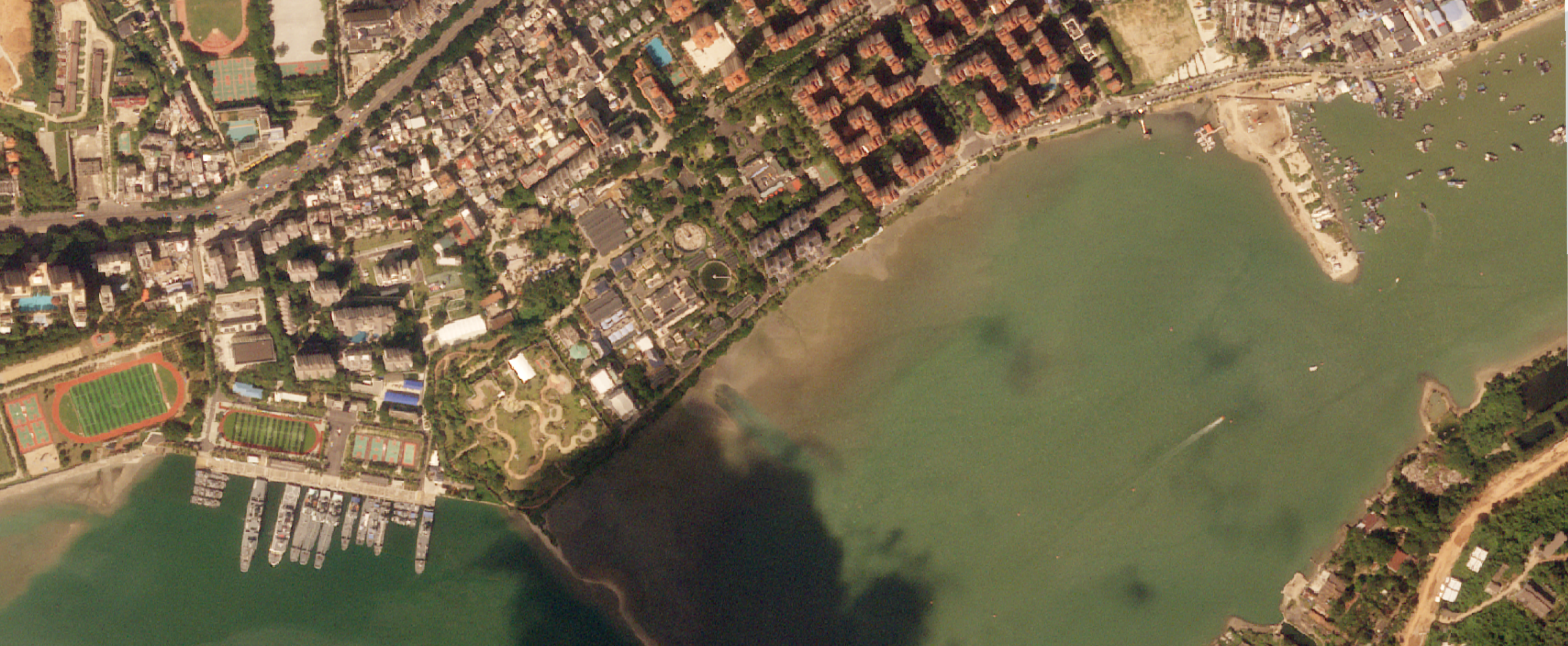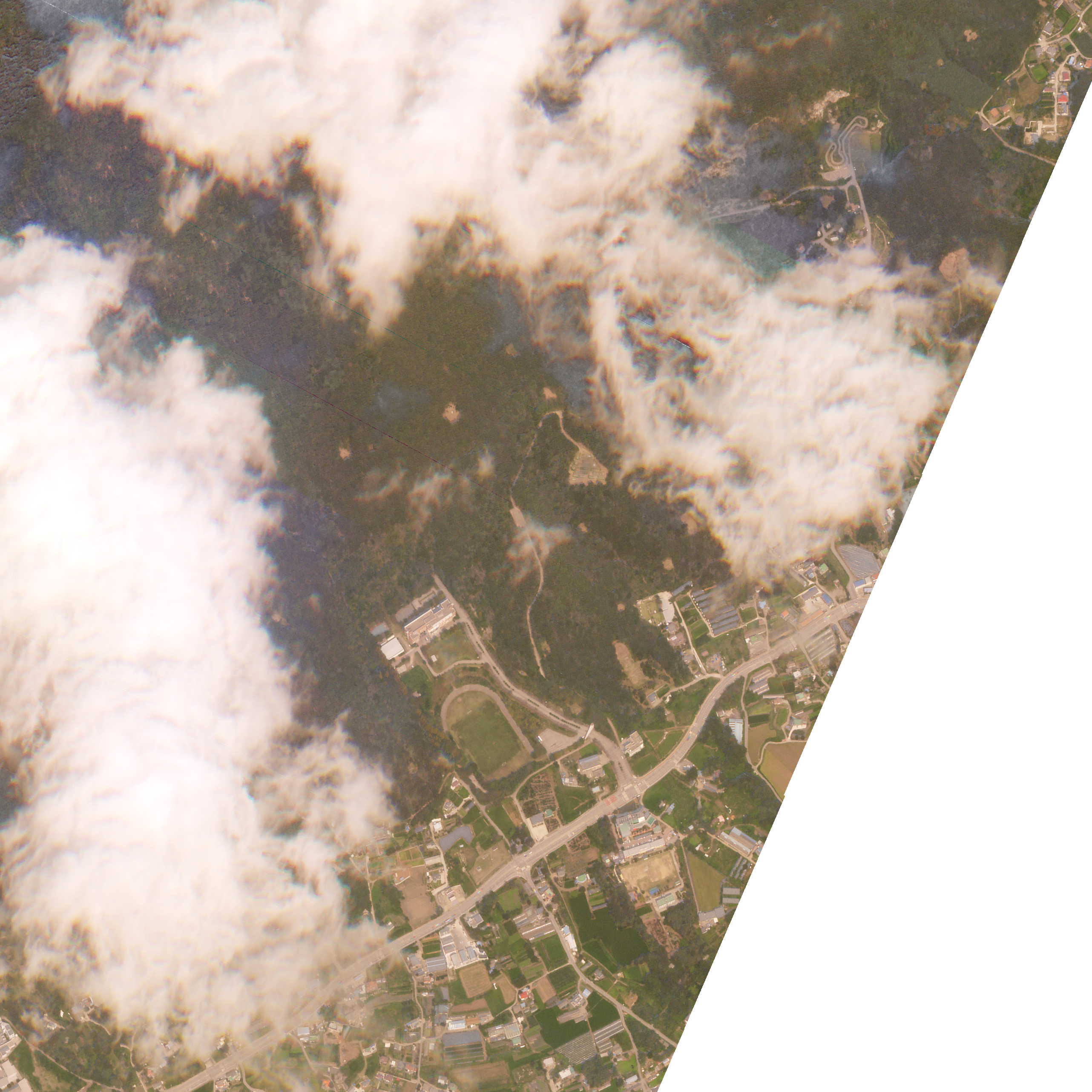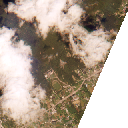L1 Basic (L1B)

Product description
The L1 Basic (aka L1B and QuickView) product is a 4-band (RGB and Near infrared) product characterised by its low processing time and that can be generated from Mark IV and Mark V satellites raw imagery. It is geolocated and projected to the ground but not orthorectified and it is presented at native resolution. This implies that different captures may have different pixel sizes depending on the altitude and the off-nadir angle of the satellite at capture time. This imagery product is currently used in Rapid Response products, as well as the base collection to browse the archive.
Technical characteristics
| Parameter | Mark IV |
Mark V |
|
|---|---|---|---|
| Spectral bands | Blue : 450 - 510 nm |
Blue : 450 - 517 nm |
|
| GSD | 0.7m - 1.35m 1 |
0.73m - 0.81 1 | |
| Scene Swath | 4.8 - 5.5 Km 1 |
6.8Km - 8.5Km 1 | |
| Image bit depth | 8-bit for VISUAL, 16 bit for TOA |
| |
| Max Off-Nadir angle | ± 25 deg |
| |
| Algorithms applied | Radiometric correction, Band Aligment, Geolocation, Projection to UTM |
| |
| Geolocation Accuracy | <= 30m TBC CE90 2 |
| |
| Band aligment | <= 2px TBC |
| |
| Image format | GeoTiff, LZW loseless compression |
| |
| Ancilliary files | Cloud and usable data mask (GeoTiff), preview (PNG) and thumbnail (PNG). |
| |
Product presentation
L1 Basic has two subproducts: the VISUAL and the TOA. The VISUAL version of the product is an 8-bit GeoTIFF and has a streched histogram that visually enhances the image for exploration purposes. The TOA (Top-of-atmosphere) version refers to a radiometrically corrected, 16-bit GeoTIFF in reflectance units (included in the metadata there are coeficcients to convert reflectance into radiance).
 The L1 Basic product can be consumed in two packaging options: as a full scene, or as tiles. On the one hand, a scene is a single image as it was captured by one of the satellites of our fleet. On the other hand, tiles are a more granular version of the same scene, that can be used for more localized exploration and consumption.
The L1 Basic product can be consumed in two packaging options: as a full scene, or as tiles. On the one hand, a scene is a single image as it was captured by one of the satellites of our fleet. On the other hand, tiles are a more granular version of the same scene, that can be used for more localized exploration and consumption.
Users can obtain L1 Basic products in two different ways: by requesting a new capture, that is, submitting a tasking order through the Tasking API and by purchasing archive data in the catalog. Currently, L1 Basic products are delivered to a pre-configured AWS S3 bucket but in the future it will be possible to download them directly from the Tasking API. Explore available L1B tiles using our Archive STAC API, under the quickview-visual and quickview-toa collections.
Projection
This imagery product is projected in the Universal Transverse Mercator (UTM) coordinate reference system. Note: if a scene is captured across different UTM zones, the entire scene/all tiles are projected to the zone with more data. The specific EPSG code (of the UTM zone) is indicated in the proj:epsg property (for tiles) or in the metadata files (for scenes).
Product components
Each L1 Basic imagery product, in both tiles and scene presentations have multiple elements associated with them as well as the corresponding metadata.
Raster, preview and thumbnail



The full resolution raster as well as downsampled versions for preview and thumbnails.
Cloud and usable data mask
Cloud masks are provided as single band GeoTIFFs. Check here for details.

Metadata
Metadata is available for the entire scene in STAC and ISO format, and per tile in STAC format. Common metadata can be found across tiles of the same capture. In tiles, the metadata corresponds to the information of that tile. For scenes, some metadata is aggregated.
The following table shows the description of each field and an example corresponding to the capture used in previous section.
| Field | Description | Example |
|---|---|---|
| gsd | The ground sampling distance of the image, in meters. | 0.78 |
| datetime | Capture date and time of the tile. In UTC. | 2023-09-22T02:29:17.823169536+00:00 |
| platform | Satellite name that acquired the imagery. | newsat13 |
| grid:code | Satellogic 2km grid code for this tile. See below. | SATL-2KM-52N_137_2088 |
| proj:epsg | The EPSG code of the projection (corresponds to a UTM zone). See below. | 32652 |
| eo:cloud_cover | The percentage of cloud cover found on the image, from 0 to 100. | 41.7 |
| view:off_nadir | The off-nadir angle for the capture measured in degrees. | 25.8465 |
| view:sun_elevation | The elevation angle of the sun at the target at the moment of the capture, in degrees. | 50.4441 |
| view:sun_azimuth | The azimuth angle of the sun at the target the with respect to the north, in degrees. | 156.912 |
| view:incidence_angle | The incidence angle is the angle between the vertical (normal) to the intercepting surface and the line of sight back to the satellite at the scene center, in degrees (0-90). | 43.4 |
| view:azimuth | Viewing azimuth angle. The angle measured from the sub-satellite point (point on the ground below the platform) between the scene center and true north. Measured clockwise from north, in degrees (0-360). | 1.212 |
| satl:outcome_id | A unique identifier of the associated capture with this tile. | d5627157-d1aa-472d-9daa-a55086fd32c2--161551 |
| satl:ground_lock | Indicates if there was enough GCP on the ground to geolocate the image. A false value indicates that the location of the image was done with onboard telemetry from the satellite and not a basemap. | True |
| satl:valid_pixel | The percentage of valid pixels on the tile. If less than 100 it means that part of the image contains no data values. | 81.533 |
| satl:haze_cover | The percentage of haze on the image, from 0 to 100 [experimental use]. | 4.9 |
| satl:product_name | The unique name of the product of which this tile corresponds to. | QUICKVIEW_VISUAL |
| satl:product_version | The version of the product. Uses semantic versioning. | 1.7.1 |
| satl:satellite_generation | Satellite model category. | MarkIV |
| satl:ba_[BAND]_response | The FFT phase correlation response between the [BAND] and the Green band. [BAND] can be Red, Blue, NIR. Typically a number >0.5 means there is good correlation between [BAND] and the Green band. | 0.785 |
| satl:ba_[BAND]_radial | Radial error between the [BAND] band and the Green band, in pixels. | 0.057 |
| satl:ba_[BAND]_xshift | X direction error between the [BAND] band and the Green band, in pixels. [BAND] can be Red, Blue, NIR. | -0.004 |
| satl:ba_[BAND]_yshift | Y direction error between the [BAND] band and the Green band, in pixels. [BAND] can be Red, Blue, NIR. | -0.057 |
| satl:geoaccuracy_[BAND]_radial | Radial error for the [BAND] band with respect to the basemap, in meters. [BAND] can be Red, Green, Blue, NIR. | 9.289 |
| satl:geoaccuracy_[BAND]_xshift | X direction error between the [BAND] band with respect to the basemap, in meters. [BAND] can be Red, Green, Blue, NIR. | 8.13 |
| satl:geoaccuracy_[BAND]_yshift | Y direction error between the [BAND] band with respect to the basemap, in meters. [BAND] can be Red, Green, Blue, NIR. | 4.495 |
| satl:geoaccuracy_[BAND]_response | The FFT phase correlation response between the Green band and the [BAND]. [BAND] can be Red, Green, Blue, NIR. Typically a number >0.5 means there is good correlation between the basemap and the image being measured. For tiles with a value lower than that, the remaining geoaccuracy measuremnents are not relevant. | 0.764 |
| satl:uint16_to_reflectance_[BAND] | The scale to apply to the DN value of every pixel to obtain reflecantes units between 0 and 1 . [BAND] can be Red, Green, Blue, NIR. Only available for TOA versions of the product. It has a fixed value. | 0.0001 |
| satl:uint16_to_radiance_[BAND] | The scale to apply to the DN value of every pixel to obtain radiance units of W/(m² sr nm) . [BAND] can be Red, Green, Blue, NIR. Only available for TOA versions of the product. | 0.0005934402 |
Packaging specification
All the components of the product are included and/or mapped into the two different packacing options, as tiles or as scenes following their corresponding support format.
Tiles
 The QuickView tiles are available on the Archive STAC API. Each STAC item is a 2km by 2km square tile.
They are aligned to a fixed discrete grid, aligned to the prime meridian of each UTM zone (coordinate 500000m). Each tile has a designated grid code included in the property grid:code as follows:
The QuickView tiles are available on the Archive STAC API. Each STAC item is a 2km by 2km square tile.
They are aligned to a fixed discrete grid, aligned to the prime meridian of each UTM zone (coordinate 500000m). Each tile has a designated grid code included in the property grid:code as follows:
SATL-<GRID SIZE>-<UTM ZONE> _ <X> _ <Y>
Where X and Y correspond to the easting and northing coordinates of the bottom left corner of the tile.
For example the grid:code SATL-2KM-10N_298_2062 should be interpreted as: - SATL grid of 2km by 2km - On UTM zone 10N - With the left bottom corner at 298,000m easting and 2062,000m northing.
Each item/tile contains the following assets/components:
| STAC Item asset name | Component |
|---|---|
| analytic | The full resolution raster corresponding to the tile. |
| preview | A 128x128 pixels PNG preview of the raster. |
| thumbnail | A 64 x 64 pixels PNG thumbnail of the raster. |
| cloud | The GeoTIFF cloud mask as defined above. |
Scenes
Scenes are delivered as a single folder. The folder name follows the following format:
<DATE>_<TIME>_SN<SATELLITE_NUMBER>_<PRODUCT_NAME>_<PAYLOAD>_<TARGET_ID> (for example 20231114_222725_SN22_L1B_MS_23322). It contains both the VISUAL and TOA versions of the product.
The content of a typical scene is detailed as follows:
.
<DATE>_<TIME>_SN<SATELLITE_NUMBER>_L1B_MS_<TARGET_ID>
├── <DATE>_<TIME>_SN<SATELLITE_NUMBER>_L1B_MS_footprint.kml
├── <DATE>_<TIME>_SN<SATELLITE_NUMBER>_L1B_MS_metadata_iso.xml
├── <DATE>_<TIME>_SN<SATELLITE_NUMBER>_L1B_MS_metadata_stac.geojson
├── <DATE>_<TIME>_SN<SATELLITE_NUMBER>_L1B_MS_preview.png
├── <DATE>_<TIME>_SN<SATELLITE_NUMBER>_L1B_MS_thumbnail.png
├── <DATE>_<TIME>_SN<SATELLITE_NUMBER>_L1B_MS_toa_factors.geojson
├── <DATE>_<TIME>_SN<SATELLITE_NUMBER>_L1B_MS_CLOUD.vrt
├── <DATE>_<TIME>_SN<SATELLITE_NUMBER>_L1B_MS_TOA.vrt
├── <DATE>_<TIME>_SN<SATELLITE_NUMBER>_L1B_MS_TOA.vrt.ovr
├── <DATE>_<TIME>_SN<SATELLITE_NUMBER>_L1B_MS_VISUAL.vrt
├── <DATE>_<TIME>_SN<SATELLITE_NUMBER>_L1B_MS_VISUAL.vrt.ovr
└── rasters
├── <DATE>_<TIME>_SN<SATELLITE_NUMBER>_L1B_MS_CLOUD_<N>.tif
├── <DATE>_<TIME>_SN<SATELLITE_NUMBER>_L1B_MS_TOA_<N>.tif
└── <DATE>_<TIME>_SN<SATELLITE_NUMBER>_L1B_MS_VISUAL_<N>.tif
| File | Description |
|---|---|
| *.vrt | A GDAL Virtual raster that contains all the corresponding TIFFs in the rasters folder. In case of long captures, multiple TIFFS can be included in the package (see paragraph below this table). CLOUD, VISUAL and TOA are the files available. |
| *.vrt.ovr | Overviews of the VRT. They are small and only a few scales are added so as not to impact negatively on the total size. |
| *_footprint.kml | The overall raster ground footprint in KML. |
| *_metadata_iso.xml | A text-based document in ISO 19115-2 format containing the key information from the metadata of the product. See the metadata section for more information. |
| *_metadata_stac.geojson | A text-based document in STAC format containing the aggregated information of the product. See the metadata section for more information. |
| *_preview.png | A lower resolution image representation of the entire scene. |
| *_thumbnail.png | An even lower resolution thumbnail of the entire scene. |
| *_toa_factors.geojson | A GeoJSON file that contains the coefficients to convert reflectance units to radiance units and digital numbers (DN). Small variation of the radiance coefficients can be expected between tiles of the same scene. |
| rasters/*_<N>.tif | The full resolution raster that comprises the full scene. For very large captures, the rasters are divided into smaller chunks. The number <N> is the chunk number. |
Scene delivery is conditional on the geographical extent of its bounding box, with a threshold of 120 kilometers established for the longest side.
- Delivery in a single chunk (below threshold): if the longest dimension of the scene's extent is less than 120 kilometers, the entire scene is presented in a single image file. In the previous table nomenclature, there will be only one chunk N=0. In particular, all standard POIs we offer (25, 50 and 100 square kilometers) are delivered in this manner.
- Chunking via fixed grid (above threshold): if the longest dimension exceeds the 120 km threshold, the scene is subjected to tiling based on a fixed, predefined grid system.
- Hierarchical grid: this system is derived from base $2 \times 2 \text{ km}$ cells (tiles grid), which are aggregated into larger delivery tiles of $80 \times 80 \text{ km}$ (resulting from $40 \times 40$ base cell groups).
- Non-constant segment size: consequently, the size and shape of the resulting output chunks are not constant. The final size of each chunk is determined by how the scene's extent intersects with the boundaries of this fixed $80 \times 80 \text{ km}$ delivery grid.


The image on the right depicts a *_toa_factors.geojson file overlaid with the scene as a reference. The polygons in the GeoJSON file correspond to the product \(2 \times 2 \text{ km}\) tiles.
Additionally, every L1B package includes a digital signature to ensure data authenticity and integrity. Each package contains a manifest file and cryptographic signature that allows verification that the delivered data has not been tampered with. Learn more about Digital Signature verification.
Changelog
[v1.9.0] 2025-11-17
- Changed cloud mask codification, from
[0: no_data, 1: valid_data, 128: shadow_data, 255: cloud]to[0: no_data, 1: clear, 2: haze, 3: cloud]. New category "clear" is analogous to the old category "valid_data". For further details check Cloud Mask section.
[v1.8.0] 2025-08-21
- Add satellite generation in STAC metadata
[v1.7.3] 2025-08-14
- Adding satellite generation field to STAC metadata.
[v1.7.2] 2025-03-26
- Better reporting of cloud coverage on fully saturated captures.
[v1.7.1] 2024-09-06
- Compatibility with L1A v1.0.0 ICD.
[v1.7.0] 2024-06-04
- Using L1A version 1.0.0.
[v1.6.0] 2024-05-21
- Added STAC properties on azimuth, ona, incidence_angle, sun azimuth and elevation on the view extension.
[v1.5.0] 2024-04-22
- Bugfixing and stability improvements.
[v1.4.0] 2024-04-12
- Bugfixing and stability improvements.
[v1.3.0] 2024-03-28
- Fix small tilings right-bottom.
- Fix on PSF deconvolution weights.
[v1.2.0] 2024-02-29
- Improved ratio of locked ground images.
- TOA conversion factors (uint16_to_radiance) metadata is now corrected.
- From this version, the Off-nadir is computed from satellite POV instead of observation POV (the elevation angle).
- Fixed extra_samples metadata removing warnings when opening files.
[v1.1.10] 2023-11-27
- TOA thumnails fixed.
- Less brightness image on Visual product.
[v1.1.9] 2023-11-16
- MarkV Orirentations should be fixed.
[v1.1.8] 2023-11-16
- Geolocation improvements.
- Over-water band alignment improved.
[v1.1.7] 2023-11-13
- Bug fixes.
- Ability to start from L1A products.
[v1.1.6] 2023-11-03
- Internal improvements, no change in imagery product.
[v1.1.5] 2023-11-03
- Band alignment improvements on saturated areas.
[v1.1.4] 2023-10-31
- Internal improvements, no change in imagery product.
[v1.1.3] 2023-10-27
- Improved thumbnail quality.
[v1.1.2] 2023-10-25
- Fixed counterclockwise exterior ring in metadata footprint [Warning: breaking change!].
- Improved saturation mask for cloud detector.
[v1.1.1] 2023-10-24
- Improved imagery sharpness.
- Fixed tile ID to reflect the real position of the tile.
[v1.1.0] 2023-10-19
- Improved visual product for consistency among very long captures.
- Tiling size to 2km.
- Changed production naming from RR to QUICKVIEW.
- Previews encoded in png now include alpha channel.
[v1.0.0] 2023-09-18
- Initial release.